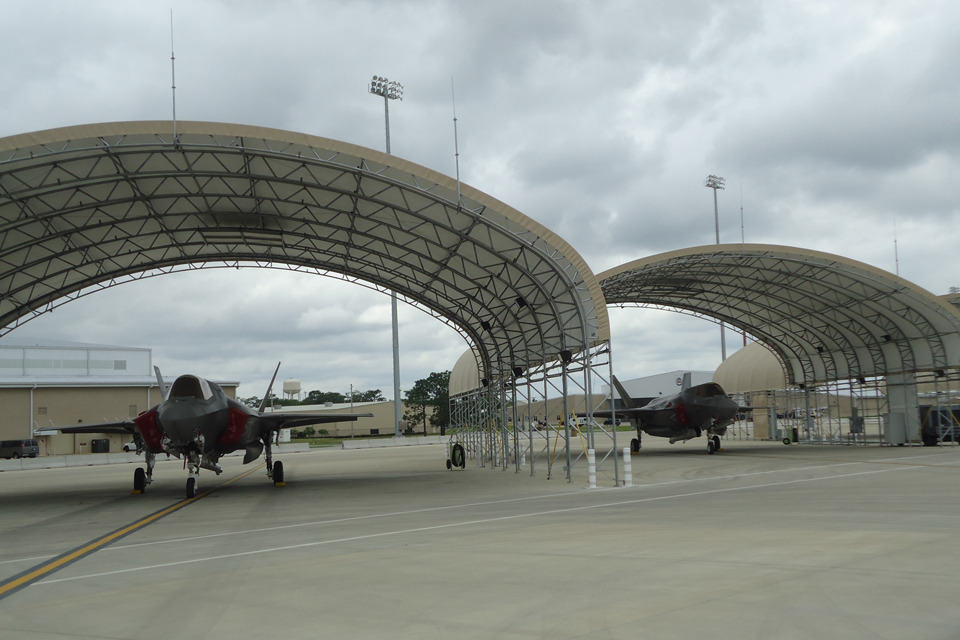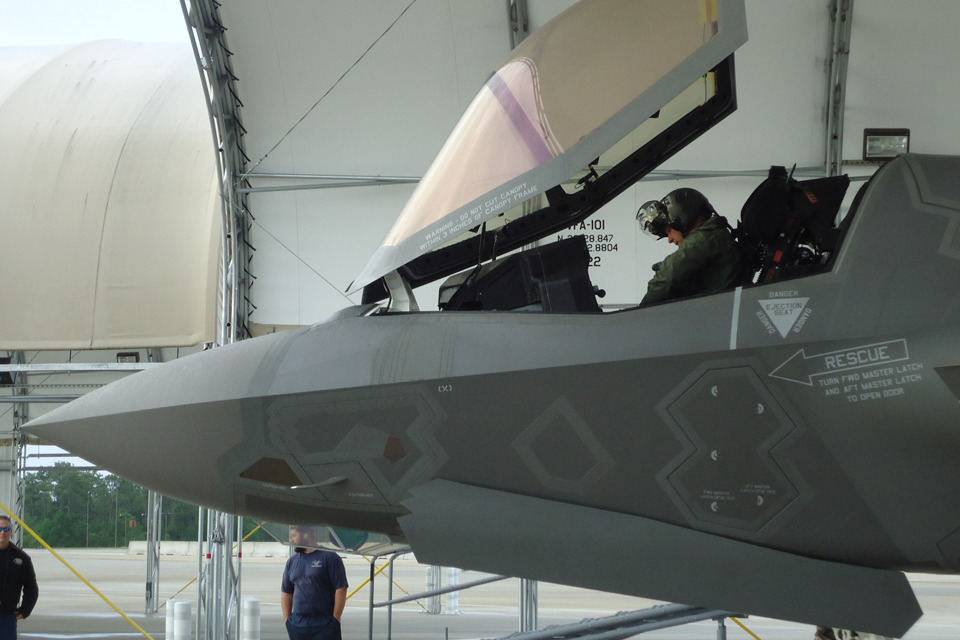Joint Strike Fighter
A small team of UK personnel are learning all about the fifth-generation stealth aircraft at Eglin Air Force Base in Florida.

Lieutenant Commander Ian Tidball with one of the UK's Lightning II aircraft at Eglin Air Force Base in Florida [Picture: Crown copyright]
So far, Britain has taken delivery of 2 Lightning II multi-role Joint Strike Fighter aircraft. The pair of STOVL (short take-off and vertical landing) variants of the F-35 fast jet are currently based at Eglin US Air Force Base in Florida and, from 2018, will be landing on the deck of the new Queen Elizabeth Class carrier.
At Eglin, 2 pilots, one Royal Navy, the other RAF, and 13 ground crew are working alongside their US Marine Corps colleagues learning all they can about maintaining the aircraft and how to fly the platforms to get the best out of them.
Although the pilots, Lieutenant Commander Ian Tidball and Squadron Leader Frankie Buchler, have only been able to practise on the aircraft for a matter of weeks, they are already singing the platform’s praises.
Selected because of his STOVL experience landing Sea Harriers on flight decks, Lieutenant Commander Tidball said:
The Lightning II is a great aircraft to fly. It’s extremely responsive with a lot of thrust. The fly-by-wire system makes it simple to fly which means the pilot is freed up to concentrate on the objectives of the mission.

The UK's 2 Lightning II aircraft at Eglin Air Force Base in Florida [Picture: Crown copyright]
As an RAF pilot who has flown Jaguars and Typhoons, Squadron Leader Buchler’s background brings experience of the UK’s modern fast jets to the team. He said:
I’m learning how to fly the aircraft so I can become a squadron instructor. Ultimately I’ll be doing operational tests on the aircraft for the Royal Navy and the RAF. I’ll be doing that for a number of years prior to it transitioning back to the UK when the first squadron of F-35Bs will stand up at RAF Marham.
Most of the pilots training at Eglin have around 50 to 60 hours on the aircraft; the most experienced has clocked up 150 hours. So far Squadron Leader Buchler has managed 20 hours, adding around 15-hours-a-month to his flying log. On top of that the pilots also train on simulators.
The aeroplane almost flies itself,” said Squadron Leader Buchler, “which means you have more time to work out what’s going on in the battlespace and how you are going to fight the fight as effectively as you can.

Lieutenant Commander Ian Tidball preparing for take-off at Eglin Air Force Base [Picture: Crown copyright]
So intelligent is the Lightning that if a novice pilot asks it to do something that it considers unsafe, it will refuse:
Some pilots will find it strange that the aircraft says ‘you know that’s silly, sorry I’m not going to do that’,” said Squadron Leader Buchler. “But it means that it’s looking out for you, so there’s less opportunity to make mistakes.
Which doesn’t mean that the technology has the final say:
You can always override it – but you’d be a fool to do so.
There is also a team of UK personnel at Patuxent River Naval Air Station in Maryland who are working on the technical development of the aircraft. Recently Defence Secretary Philip Hammond visited the air station to meet the UK team involved in testing the Joint Strike Fighter aircraft and watched as a Lightning II performed a vertical landing.
Next year the team at Eglin will move to Edwards Air Force Base in California to conduct flying operations. Lieutenant Commander Ian Tidball said:
At the moment our maintenance personnel, 7 Navy and 6 RAF, are gaining experience on how to look after the aircraft so that when we go to Edwards we will be able to stand up and operate as an autonomous unit.